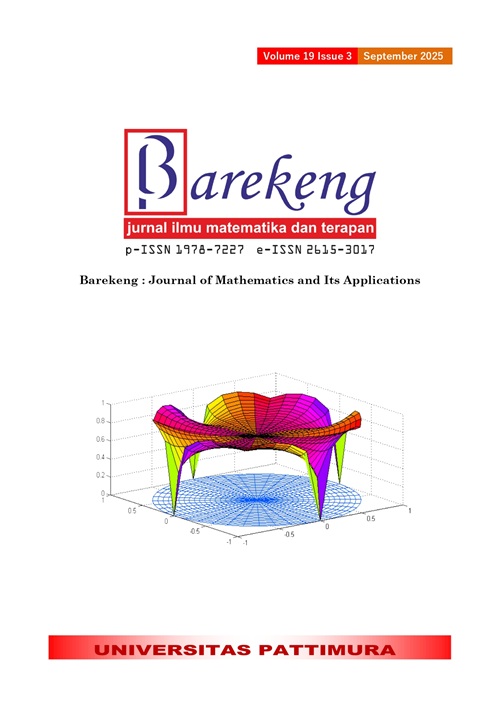COMPARISON OF LEAST SQUARE SPLINE AND ARIMA MODELS FOR PREDICTING INDONESIA COMPOSITE INDEX
Abstract
The Indonesian Composite Index (ICI) reflects Indonesia's economic growth. ICI predictions are significant considerations for investors when making investment decisions. Two approaches can be used to predict ICI: parametric and nonparametric approaches. Therefore, this study compares parametric and nonparametric approaches to predict ICI. In its application, the parametric approach requires several assumptions to be met, such as linearity. This differs from analysis with a nonparametric approach that does not require certain assumptions. The parametric approach in this study uses the ARIMA model. ARIMA is widely used to predict time series data. In the nonparametric approach, in this study, we used nonparametric regression based on the least square spline. Spline is chosen because it can handle data that tends to fluctuate by placing knot points when data changes occur. In this study, ICI monthly data obtained from the website investing.com was used. Investing.com is a website that financial analysts often use as a data source to monitor world economic conditions, including the ICI. The Mean Absolute Percentage Error (MAPE) value is determined to assess the accuracy of the prediction. The study results indicate that the analysis with ARIMA cannot meet the assumptions, so ARIMA modeling cannot be continued. Different results were obtained in nonparametric regression modeling based on the least square spline estimator. Prediction of ICI using nonparametric regression based on the least square spline estimator has a MAPE value of 2.613% (less than 10%), which means the model is a highly accurate prediction, meaning modeling using nonparametric regression based on the least square spline estimator is better than the ARIMA model for predicting ICI.
Downloads
References
M. E. Barth, S. F. Cahan, L. Chen, and E. R. Venter, “THE ECONOMIC CONSEQUENCES ASSOCIATED WITH INTEGRATED REPORT QUALITY: CAPITAL MARKET AND REAL EFFECTS,” Accounting, Organizations and Society, vol. 62, pp. 43–64, Oct. 2017, doi: https://doi.org/10.1016/j.aos.2017.08.005.
M. I. Rosyadi, A. Widowati, and P. C. Jamil, “ANALYSIS OF CORRELATION BETWEEN INDONESIAN COMPOSITE INDEX AND ECONOMIC GROWTH IN INDONESIA,” EJBM, Mar. 2020, doi: 10.7176/EJBM/12-8-07.
M. R. Apituley, “THE EFFECT OF RUPIAH EXCHANGE RATE AND INFLATION RATE TOWARDS COMPOSITE STOCK PRICE INDEX IN INDONESIA STOCK EXCHANGE,” RJOAS, vol. 78, no. 6, Art. no. 6, Jun. 2018, doi: https://doi.org/10.18551/rjoas.2018-06.05.
Y. Xiu, G. Wang, and W. K. V. Chan, “CRASH DIAGNOSIS AND PRICE REBOUND PREDICTION IN NYSE COMPOSITE INDEX BASED ON VISIBILITY GRAPH AND TIME-EVOLVING STOCK CORRELATION NETWORK,” Entropy, vol. 23, no. 12, Art. no. 12, Nov. 2021, doi: https://doi.org/10.3390/e23121612.
I. R. Hikmah, A. Saefuddin, and I. W. Manku, “IDENTIFICATION OF DEPENDENT STRUCTURE AND PREDICTION OF COMPOSITE STOCK PRICE INDEX WITH CD VINE COPULA APPROACH,” International Journal of Scientific & Engineering Research, vol. 8, no. 7, Art. no. 7, Jul. 2017.
Y. Huang, “Prediction of the Stock Price of Shanghai Securities Composite Index by Using Time-series Model,” in 2022 6th International Conference on E-Commerce, E-Business and E-Government, Plymouth United Kingdom: ACM, Apr. 2022, pp. 237–242. doi: https://doi.org/10.1145/3537693.3537729.
Z. Lin, “MODELLING AND FORECASTING THE STOCK MARKET VOLATILITY OF SSE COMPOSITE INDEX USING GARCH MODELS,” Future Generation Computer Systems, vol. 79, pp. 960–972, Feb. 2018, doi: 1 https://doi.org/10.1016/j.future.2017.08.033.
S. Siami-Namini, N. Tavakoli, and A. S. Namin, “A COMPARATIVE ANALYSIS OF FORECASTING FINANCIAL TIME SERIES USING ARIMA, LSTM, AND BILSTM,” 2019, arXiv. doi: 10.48550/ARXIV.1911.09512.
N. Latif, J. D. Selvam, M. Kapse, V. Sharma, and V. Mahajan, “COMPARATIVE PERFORMANCE OF LSTM AND ARIMA FOR THE SHORT-TERM PREDICTION OF BITCOIN PRICES,” AABFJ, vol. 17, no. 1, pp. 256–276, 2023, doi: https://doi.org/10.14453/aabfj.v17i1.15.
D. Benvenuto, M. Giovanetti, L. Vassallo, S. Angeletti, and M. Ciccozzi, “APPLICATION OF THE ARIMA MODEL ON THE COVID-2019 EPIDEMIC DATASET,” Data in Brief, vol. 29, p. 105340, Apr. 2020, doi: https://doi.org/10.1016/j.dib.2020.105340.
R. L. Eubank, NONPARAMETRIC REGRESSION AND SPLINE SMOOTHING, CRC Press, 1999. doi: https://doi.org/10.1201/9781482273144.
B. Zhou, X. Ma, Y. Luo, and D. Yang, “WIND POWER PREDICTION BASED ON LSTM NETWORKS AND NONPARAMETRIC KERNEL DENSITY ESTIMATION,” IEEE Access, vol. 7, pp. 165279–165292, 2019, doi: https://doi.org/10.1109/ACCESS.2019.2952555.
B. Feriel and O. S. Elias, “NONPARAMETRIC LOCAL LINEAR ESTIMATION OF THE RELATIVE ERROR REGRESSION FUNCTION FOR TWICE CENSORED DATA,” Statistics & Probability Letters, vol. 178, p. 109185, Nov. 2021, doi: https://doi.org/10.1016/j.spl.2021.109185.
M. Ulya and N. Chamidah, “MULTI-PREDICTOR LOCAL POLYNOMIAL REGRESSION FOR PREDICTING THE ACIDITY LEVEL OF AVOMANGO (GADUNG KLONAL 21),” presented at the International Conference On Mathematics, Computational Sciences And Statistics, Surabaya, Indonesia, 2021, p. 060024. doi: https://doi.org/10.1063/5.0042290.
N. Chamidah, A. Kurniawan, B. Zaman, and L. Muniroh, “LEAST SQUARE-SPLINE ESTIMATOR IN MULTI-RESPONSE SEMIPARAMETRIC REGRESSION MODEL FOR ESTIMATING MEDIAN GROWTH CHARTS OF CHILDREN IN EAST JAVA, INDONESIA,” FJMS, vol. 107, no. 2, Art. no. 2, Oct. 2018, doi: https://doi.org/10.17654/MS107020295.
J. Orbe and J. Virto, “PENALIZED SPLINE SMOOTHING USING KAPLAN–MEIER WEIGHTS WITH CENSORED DATA,” Biometrical J, vol. 60, no. 5, pp. 947–961, Sep. 2018, doi: https://doi.org/10.1002/bimj.201700213.
E. Pusporani et al., “PREDICTION OF NATIONAL STRATEGIC COMMODITY PRICES BASED ON MULTIVARIATE NONPARAMETRIC TIME SERIES ANALYSIS,” Commun. Math. Biol. Neurosci., 2022, doi: 10.28919/cmbn/7712.
J. Yu, J. Shi, A. Liu, and Y. Wang, “SMOOTHING SPLINE SEMIPARAMETRIC DENSITY MODELS,” Journal of the American Statistical Association, vol. 117, no. 537, pp. 237–250, Jan. 2022, doi: https://doi.org/10.1080/01621459.2020.1769636.
A. Halida, N. Salam, and A. S. Lestia, “MODELING OF POVERTY IN KALIMANTAN WITH NONPARAMETRIC SPLINE REGRESSION APPROACH,” J. Phys.: Conf. Ser., vol. 2106, no. 1, p. 012008, Nov. 2021, doi: https://doi.org/10.1088/1742-6596/2106/1/012008.
N. Chamidah, B. Lestari, A. Y. Wulandari, and L. Muniroh, “Z-SCORE STANDARD GROWTH CHART DESIGN OF TODDLER WEIGHT USING LEAST SQUARE SPLINE SEMIPARAMETRIC REGRESSION,” presented at the International Conference On Mathematics, Computational Sciences And Statistics, Surabaya, Indonesia, 2021, p. 060031. doi: https://doi.org/10.1063/5.0042285.
F. Rahim, I. N. Budiantara, and E. O. Permatasari, “SPLINE TRUNCATED NONPARAMETRIC REGRESSION MODELING FOR MATERNAL MORTALITY RATE IN EAST JAVA,” Inferensi, vol. 2, no. 1, p. 39, Mar. 2019, doi: https://doi.org/10.12962/j27213862.v2i1.6812.
V. Fibriyani and N. Chamidah, “PREDICTION OF INFLATION RATE IN INDONESIA USING LOCAL POLYNOMIAL ESTIMATOR FOR TIME SERIES DATA,” J. Phys.: Conf. Ser., vol. 1776, no. 1, Art. no. 1, Feb. 2021, doi: ttps://doi.org/10.1088/1742-6596/1776/1/012065.
Z. Amry and B. H. Siregar, “ARIMA MODEL SELECTION FOR COMPOSITE STOCK PRICE INDEX IN INDONESIA STOCK EXCHANGE,” IJAFS, vol. 2, no. 1, p. p31, May 2019, doi: https://doi.org/10.22158/ijafs.v2n1p31.
D. Gunawan and W. Astika, “THE AUTOREGRESSIVE INTEGRATED MOVING AVERAGE (ARIMA) MODEL FOR PREDICTING JAKARTA COMPOSITE INDEX,” INFEB, Feb. 2022, doi: https://doi.org/10.37034/infeb.v4i1.114.
S. F. Adyatma and A. Alamsyah, “THE INDONESIA STOCK EXCHANGE COMPOSITE PREDICTION BASED ON MACROECONOMIC INDICATORS USING ARIMA, LSTM, AND ANN,” in 2022 8th International Conference on Science and Technology (ICST), Yogyakarta, Indonesia: IEEE, Sep. 2022, pp. 1–5. doi: https://doi.org/10.1109/ICST56971.2022.10136262.
F. Stoppa, C. Johnston, E. Cator, G. Nelemans, and P. J. Groot, “FINKER: FREQUENCY IDENTIFICATION THROUGH NONPARAMETRIC KERNEL REGRESSION IN ASTRONOMICAL TIME SERIES,” A&A, vol. 686, p. A158, Jun. 2024, doi: https://doi.org/10.1051/0004-6361/202348848.
Y. Yan, J. Gao, and B. Peng, “A CLASS OF TIME-VARYING VECTOR MOVING AVERAGE MODELS: NONPARAMETRIC KERNEL ESTIMATION AND APPLICATION,” 2020, doi: 10.48550/ARXIV.2010.01492.
C. Dong, J. Gao, and B. Peng, “VARYING-COEFFICIENT PANEL DATA MODELS WITH NONSTATIONARITY AND PARTIALLY OBSERVED FACTOR STRUCTURE,” Journal of Business & Economic Statistics, vol. 39, no. 3, pp. 700–711, Jul. 2021, doi: https://doi.org/10.1080/07350015.2020.1721294.
V. Fibriyani and N. Chamidah, “PREDICTION OF INFLATION IN INDONESIA USING NONPARAMETRIC REGRESSION APPROACH BASED ON LOCAL POLYNOMIAL ESTIMATOR:,” in Proceedings of the 2nd International Seminar on Science and Technology (ISSTEC 2019), Yogyakarta, Indonesia: Atlantis Press, 2020. doi: ttps://doi.org/10.2991/assehr.k.201010.013
N. Chamidah, B. Lestari, A. Massaid, and T. Saifudin, “ESTIMATING MEAN ARTERIAL PRESSURE AFFECTED BY STRESS SCORES USING SPLINE NONPARAMETRIC REGRESSION MODEL APPROACH,” cmbn, 2020, doi: 10.28919/cmbn/4963.
Choden and S. Unhapipat, “ARIMA MODEL TO FORECAST INTERNATIONAL TOURIST VISIT IN BUMTHANG, BHUTAN,” J. Phys.: Conf. Ser., vol. 1039, p. 012023, Jun. 2018, doi: https://doi.org/10.1088/1742-6596/1039/1/012023.
D. C. Montgomery, C. L. Jennings, and M. Kulahci, INTRODUCTION TO TIME SERIES ANALYSIS AND FORECASTING, 2nd ed. New Jersey: John Wiley and Sons, 2015. Accessed: Dec. 07, 2024. [Online]. Available: https://onlinelibrary.wiley.com/doi/10.1111/jtsa.12203
B. S. Pratama, A. F. Suryono, N. Auliyah, and N. Chamidah, “COMPARISON OF LOCAL POLYNOMIAL REGRESSION AND ARIMA IN PREDICTING THE NUMBER OF FOREIGN TOURIST VISITS TO INDONESIA,” BAREKENG: J. Math. & App., vol. 18, no. 1, pp. 0053–0064, Mar. 2024, doi: https://doi.org/10.30598/barekengvol18iss1pp0043-0052.
I. R. Nur Wisisono, A. I. Nurwahidah, and Y. Andriyana, “REGRESI NONPARAMETRIK DENGAN PENDEKATAN DERET FOURIER PADA DATA DEBIT AIR SUNGAI CITARUM,” JMM, vol. 4, no. 2, pp. 75–82, Oct. 2018, doi: https://doi.org/10.15642/mantik.2018.4.2.75-82.
Copyright (c) 2025 Any Tsalasatul Fitriyah, Nur Chamidah, Toha Saifudin

This work is licensed under a Creative Commons Attribution-ShareAlike 4.0 International License.
Authors who publish with this Journal agree to the following terms:
- Author retain copyright and grant the journal right of first publication with the work simultaneously licensed under a creative commons attribution license that allow others to share the work within an acknowledgement of the work’s authorship and initial publication of this journal.
- Authors are able to enter into separate, additional contractual arrangement for the non-exclusive distribution of the journal’s published version of the work (e.g. acknowledgement of its initial publication in this journal).
- Authors are permitted and encouraged to post their work online (e.g. in institutional repositories or on their websites) prior to and during the submission process, as it can lead to productive exchanges, as well as earlier and greater citation of published works.






1.gif)



